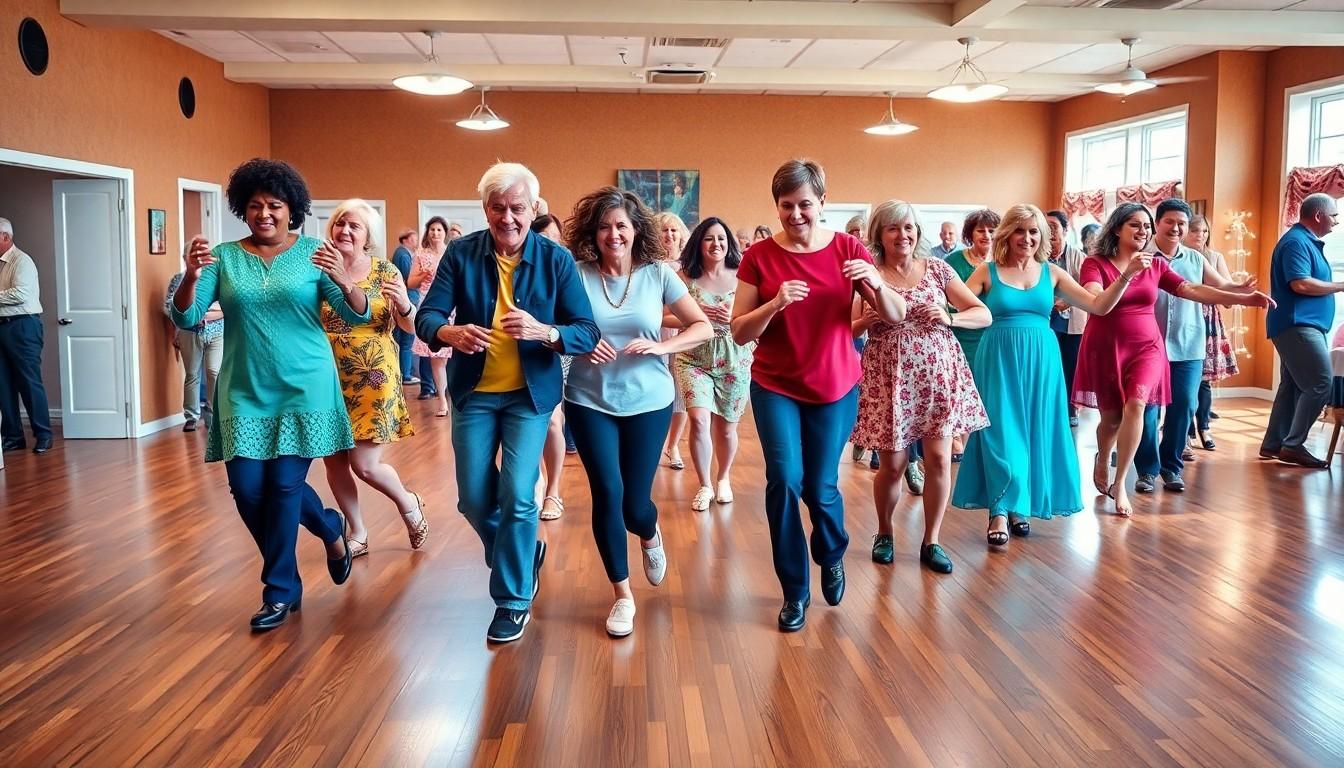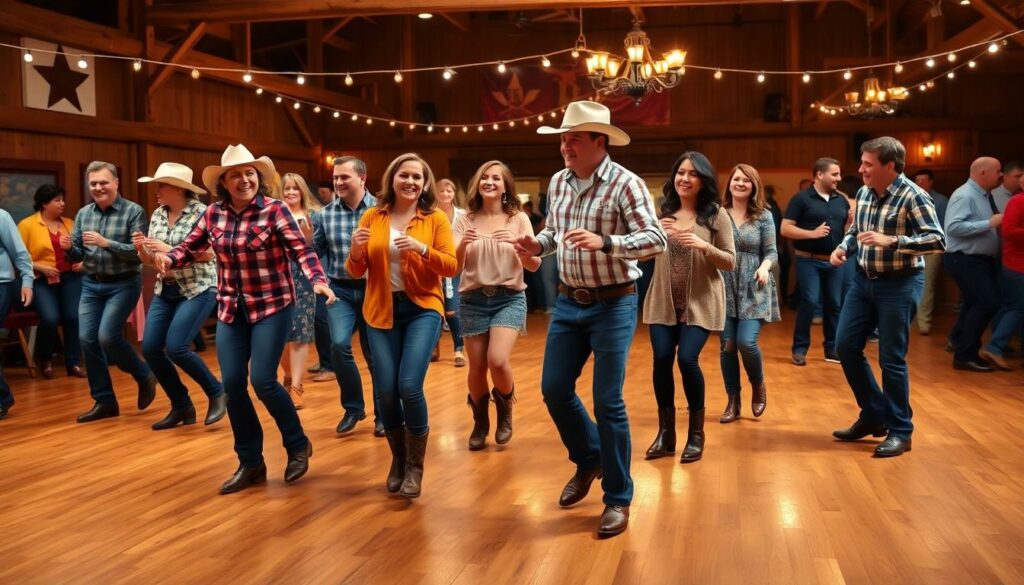Line dancing combines the thrill of dancing with the joy of moving in perfect synchronization. From country classics to modern pop hits these catchy tunes have transformed dance floors into a unified display of stomping boots and swaying hips.
Whether you’re a seasoned line dancer or just looking to join the fun there’s something magical about the moment when everyone knows exactly which move comes next. The right song can turn even the most hesitant wallflower into a confident dancer ready to tackle the Electric Slide Cupid Shuffle or Boot Scootin’ Boogie. The best part? No partner required – just a willingness to learn and a desire to have fun.
Line Dancing Songs
Line dancing songs span multiple decades genres with distinct choreography that unites dancers on the floor. These iconic tracks create memorable moments at dance venues worldwide.
Classic Country Line Dancing Hits
The Electric Slide pairs perfectly with Brooks & Dunn’s “Boot Scootin’ Boogie” from 1992, driving dancers through its signature 4-wall pattern. Billy Ray Cyrus’s “Achy Breaky Heart” emerged as a line dancing phenomenon in 1992, introducing millions to the basic grapevine step sequence. Tracy Lawrence’s “Good Until Gone” features a straightforward dance pattern that integrates kicks heel touches. The Copperhead Road dance accompanies Steve Earle’s 1988 hit song combining military-style movements with traditional country steps. Alan Jackson’s “Chattahoochee” incorporates jazz boxes vine steps making it a staple at country dance venues since 1993.
Modern Pop Songs for Line Dancing
Contemporary line dancing embraces pop hits like “Cupid Shuffle” by Cupid featuring simple repeating steps that appeal to beginners. “Blurred Lines” by Robin Thicke sparked a new line dance variation mixing hip-hop elements with traditional patterns. Meghan Trainor’s “All About That Bass” inspired a popular routine combining cha-cha steps with modern moves. The “Wobble” by V.I.C. created its own dance phenomenon with hip movements synchronized steps. DJ Casper’s “Cha Cha Slide” remains a crowd favorite at events featuring clear vocal instructions for each movement sequence.
Essential Line Dance Steps and Moves

Line dancing combines simple footwork patterns with coordinated body movements to create synchronized routines. These patterns build from basic steps to complex combinations.
Basic Steps for Beginners
The grapevine step forms the foundation of many line dances, involving four counts of sideways movement while crossing feet. Dancers start with the basic two-step, moving forward or back with alternating feet. The shuffle step adds rhythmic movement by combining three quick steps in a “quick-quick-slow” pattern. The coaster step involves stepping back then forward in a three-count movement. Common turns include the 1/4 turn pivots clockwise or counterclockwise. The box step creates a square pattern on the floor through forward side back movements. Each step repeats in sequences of 4 8 16 or 32 counts.
Advanced Combinations
Advanced line dancers incorporate heel splits rock steps body rolls hip sways into their routines. The sailor step creates intricate foot patterns while maintaining rhythm. Triple steps add speed variations combining three quick steps in one beat. Syncopated movements mix different timing patterns creating dynamic sequences. Charleston kicks jazz squares kick-ball-changes elevate routines beyond basic footwork. Rolling vine turns complete 360-degree rotations while traveling across the floor. Experienced dancers seamlessly transition between steps maintaining continuous flow throughout complex eight-wall sequences.
Best Country Line Dancing Songs by Decade
Line dancing songs evolved significantly through different decades, creating unique choreographic trends. Each era brought distinctive rhythms that shaped the dance culture in country venues across America.
1990s Country Dance Favorites
The 1990s marked a golden era for country line dancing with chart-topping hits that remain popular today. “Boot Scootin’ Boogie” by Brooks & Dunn dominated dance floors in 1992 with its infectious rhythm. Tracy Byrd’s “Watermelon Crawl” introduced a signature dance that spread rapidly through country venues in 1994. Additional 90s classics include “Any Man of Mine” by Shania Twain, “Down at the Twist and Shout” by Mary Chapin Carpenter “Gone Country” by Alan Jackson.
| Song Title | Artist | Release Year |
|---|---|---|
| Boot Scootin’ Boogie | Brooks & Dunn | 1992 |
| Watermelon Crawl | Tracy Byrd | 1994 |
| Any Man of Mine | Shania Twain | 1995 |
Modern Country Line Dancing Tracks
Contemporary country artists continue creating line dance anthems with fresh choreography patterns. Blake Shelton’s “Honey Bee” features simple steps perfect for beginners. Luke Bryan’s “Country Girl (Shake It for Me)” incorporates hip-hop elements into traditional country moves. Lady Antebellum’s “Downtown” brings urban energy to line dancing floors. Florida Georgia Line’s “Cruise” demonstrates the evolution of country dance music with its modern production style.
| Song Title | Artist | Dance Difficulty |
|---|---|---|
| Honey Bee | Blake Shelton | Beginner |
| Country Girl | Luke Bryan | Intermediate |
| Downtown | Lady Antebellum | Intermediate |
| Cruise | Florida Georgia Line | Advanced |
How to Choose Songs for Line Dancing
Selecting appropriate songs for line dancing requires careful consideration of specific musical elements. The right song choice ensures dancers stay synchronized while maintaining an engaging atmosphere on the dance floor.
Rhythm and Beat Requirements
Line dancing songs feature a consistent beat pattern of 4/4 time signature with 32-count phrases. The ideal tempo ranges from 112 to 128 beats per minute (BPM), allowing dancers to execute steps comfortably. Songs with clear downbeats make it easier for dancers to stay on rhythm, particularly in country classics like “Boot Scootin’ Boogie” at 126 BPM. Modern line dance hits incorporate various rhythmic elements:
-
- Strong percussion sections for step emphasis
-
- Regular instrumental breaks for movement transitions
-
- Steady bass lines that guide foot placement
-
- Distinct musical phrases marking routine sections
Song Length and Structure
The optimal length for line dancing songs spans 3 to 4 minutes, providing enough time to complete multiple sequences. Effective line dance songs contain these structural elements:
-
- 16 or 32-count musical phrases
-
- Consistent verse-chorus patterns
-
- Clear instrumental sections for dance breaks
-
- Minimal tempo changes throughout
-
- Recognizable endings for routine completion
Songs structured with repetitive elements enable dancers to anticipate upcoming sequences. Popular tracks like “Cupid Shuffle” demonstrate this format with its predictable pattern changes every 32 counts.
Playlists for Different Line Dancing Events
Wedding receptions feature upbeat line dance songs like “Cha Cha Slide,” “Cupid Shuffle” and “YMCA” to encourage group participation.
Family reunions embrace country classics such as:
-
- “Boot Scootin’ Boogie” by Brooks & Dunn
-
- “Watermelon Crawl” by Tracy Byrd
-
- “Achy Breaky Heart” by Billy Ray Cyrus
Corporate events mix modern hits with traditional favorites:
-
- “Blurred Lines” by Robin Thicke
-
- “Uptown Funk” by Mark Ronson ft. Bruno Mars
-
- “Cotton Eye Joe” by Rednex
Senior centers focus on slower-paced classics:
-
- “Electric Slide” by Marcia Griffiths
-
- “Chattahoochee” by Alan Jackson
-
- “Tush Push” by various artists
| Event Type | Recommended BPM | Average Song Length |
|---|---|---|
| Weddings | 120-128 BPM | 3-4 minutes |
| Family Events | 112-124 BPM | 3-5 minutes |
| Corporate | 116-126 BPM | 3-4 minutes |
| Senior Events | 108-116 BPM | 3-4 minutes |
Dance instructors customize playlists based on skill levels:
-
- Beginner sessions include repetitive songs with clear vocal cues
-
- Intermediate classes incorporate songs with varied tempos
-
- Advanced groups tackle complex routines set to faster beats
-
- “Save a Horse (Ride a Cowboy)” by Big & Rich
-
- “Wobble” by V.I.C.
-
- “Copperhead Road” by Steve Earle
Creating Your Own Line Dancing Mix
A successful line dancing mix balances diverse tempos with consistent rhythms. Songs with a 4/4 time signature form the foundation of any effective playlist, maintaining beats between 112-128 BPM for optimal dancing flow.
Song Selection Guidelines
-
- Pick tracks with clear verse-chorus structures
-
- Include familiar hits from multiple decades
-
- Mix country classics with contemporary pop songs
-
- Balance slow starter songs with high-energy numbers
-
- Alternate between different dance styles
Playlist Structure
| Dance Level | BPM Range | Songs Per Hour | Break Duration |
|---|---|---|---|
| Beginners | 112-120 | 12-15 | 5 minutes |
| Intermediate | 120-124 | 15-18 | 3 minutes |
| Advanced | 124-128 | 18-20 | 2 minutes |
Transition Tips
-
- Match similar BPMs between consecutive songs
-
- Group dances by difficulty level
-
- Alternate between line dance styles
-
- Space popular favorites throughout the mix
-
- Insert mini-breaks after intense routines
Digital mixing tools like Virtual DJ or Spotify help create seamless transitions between songs. Professional DJs organize their playlists using color-coding systems to identify dance types, energy levels or difficulty ratings. Music streaming platforms offer pre-made line dancing playlists that serve as templates for custom mixes.
Music and Synchronized Movement
Line dancing continues to captivate dancers of all ages and skill levels with its infectious blend of music and synchronized movement. From timeless country classics to modern pop hits the dance floor welcomes everyone to join in the fun.
Whether it’s a wedding celebration family gathering or corporate event line dancing creates memorable moments that bring people together. With the right song selection and playlist organization dancers can experience the joy of moving as one while building confidence and community on the dance floor.
The enduring popularity of line dancing proves that this inclusive social activity isn’t just a passing trend – it’s a beloved tradition that continues to evolve and inspire new generations of dancers.

